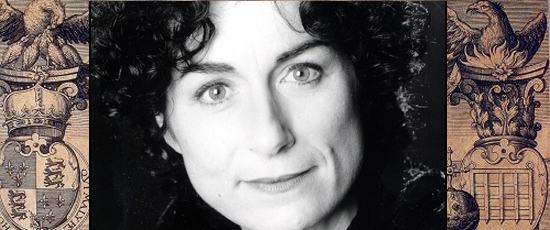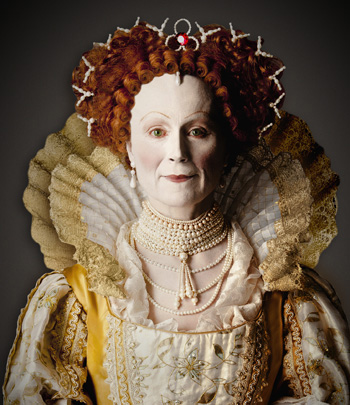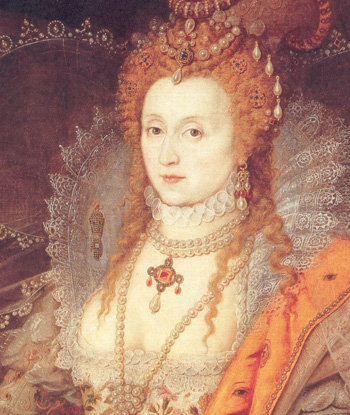Role Playing: Diane D’Aquila’s twice regal portrait as lover-monarch in ‘Elizabeth Rex’
 Interview: As Queen Elizabeth I, D’Aquila explores the heart of a woman who sends a treasonous lover to his death. Timothy Findley’s play runs through Jan. 22 at Chicago Shakespeare Theater.
Interview: As Queen Elizabeth I, D’Aquila explores the heart of a woman who sends a treasonous lover to his death. Timothy Findley’s play runs through Jan. 22 at Chicago Shakespeare Theater.
By Lawrence B. Johnson
Diane D’Aquila, who brings Queen Elizabeth I to regal and vulnerable life in Timothy Findley’s “Elizabeth Rex” at Chicago Shakespeare Theater, says acting in this gripping, keenly honed production “is a like a dance out there, and it’s scary as hell.”
 To put it mildly, “Elizabeth Rex” is an intensely emotional play. It’s Findley’s imagined riff on the historical night before Elizabeth’s former lover Robert Devereux, the Earl of Essex, is put to death for treason. Distraught with grief at having to go through with Essex’s execution, Elizabeth has beguiled the evening by watching a command performance of Shakespeare’s “Much Ado About Nothing.” Now she seeks further distraction – by joining the Bard and his fellow thespians in the royal stables as she awaits the death knell.
To put it mildly, “Elizabeth Rex” is an intensely emotional play. It’s Findley’s imagined riff on the historical night before Elizabeth’s former lover Robert Devereux, the Earl of Essex, is put to death for treason. Distraught with grief at having to go through with Essex’s execution, Elizabeth has beguiled the evening by watching a command performance of Shakespeare’s “Much Ado About Nothing.” Now she seeks further distraction – by joining the Bard and his fellow thespians in the royal stables as she awaits the death knell.
But the queen gets more than she bargained for. Her internal conflict between Elizabeth the monarch and Elizabeth the woman is thrown up in her face by one of the players, Ned Lowenscroft, the master interpreter of Shakespeare’s women’s roles who also happens to be terminally ill.
 “Elizabeth begins by telling Ned, ‘I require distraction,’” says D’Aquila, “and, boy, does she get it. She invites him to ‘play whatever you choose, whatever role, whatever temper.’ She doesn’t realize what she’s getting herself into. But she also tells Ned, ‘I’ll teach you how to be a man if you can teach me how to be a woman.’ Ned is a loose cannon. He’s openly gay, a bit of a bad boy and a trickster, and he has been deeply hurt in a relationship. But there’s nothing wimpy about him. He’s male and Elizabeth loves that. He’s also very emotional. He declares that men weep, that it’s not just feminine.” Thereby suggesting that it’s admissible for the queen to shed tears for Robert.
“Elizabeth begins by telling Ned, ‘I require distraction,’” says D’Aquila, “and, boy, does she get it. She invites him to ‘play whatever you choose, whatever role, whatever temper.’ She doesn’t realize what she’s getting herself into. But she also tells Ned, ‘I’ll teach you how to be a man if you can teach me how to be a woman.’ Ned is a loose cannon. He’s openly gay, a bit of a bad boy and a trickster, and he has been deeply hurt in a relationship. But there’s nothing wimpy about him. He’s male and Elizabeth loves that. He’s also very emotional. He declares that men weep, that it’s not just feminine.” Thereby suggesting that it’s admissible for the queen to shed tears for Robert.
Well versed in real-life suffering and with nothing to lose, Ned (Steven Sutcliffe) prods the troubled Elizabeth with the audacity – and impunity – of one of Shakespeare’s wise fools. And so the night spins inexorably toward the terrible dawn and apparent certainty that the queen’s beloved Robert will meet his doom.
D’Aquila, a Minneapolis native who now lives in Toronto, was a close friend of Findley (1930-2002) and created the role of Elizabeth when the play premiered at the Stratford (Ontario) Shakespeare Festival in 2001. In revisiting the queen’s torment at CST, she says she was reminded that it’s a long night for Her Highness. To play out too much of the emotional string too soon can rob the drama of its powerful ending.
“As an actor, you want to go straight to that emotion, the core of what makes it a drama,” says D’Aquila. “I call it going to the pity party, where you can feel sorry for yourself. But if you hang on to that intellectually, and not go there emotionally until the very end, you build something of great strength. As Elizabeth, I have to leave the emotional realm to Ned. That’s his territory.
“Elizabeth had to be masculine just to survive. Women can understand the conflict. I’ve been amazed at how many men have also come up and told me how moved they were.”
The very title of the play reflects the queen’s perilous position. In the course of the night, the woman who should be called Elizabeth Regina (Queen) styles herself Elizabeth Rex (King), a pithy summation of the transgender, double life she leads. When D’Aquila first prepared to play the role – “God knows I read just about everything written on the subject” – she came to appreciate Elizabeth as an extraordinary woman in a man’s world, and as a daughter with highly conflicted feelings toward her father, Henry VIII.
“Henry was a beloved king, as she was beloved as queen. He was bigger than life, and she spent much of her life emulating him. He was the showman, an artist. He loved hunting and bear-baiting and dressing up. But he also had Elizabeth’s mother beheaded. After her mother was killed, she was sent off to her own little palace, away from London. Very occasionally, Henry would come to see her. But she had the same education as her half-brother Edward — multiple languages, a knowledge of history. And she learned to survive at a very young age.
“That’s probably why she never married. I’m sure her feelings about men were pretty dicey. Freud would have had a heyday. But she had close women friends at court, and Essex wasn’t her first lover. She loved to flirt and dance. She was surrounded by married men who spent months on end at court – and she would have been more male than many of the men. They of course had to tell her how beautiful she was. Courtly love flourished under Elizabeth.”
 And so did the arts, theater among them. The historical Elizabeth was familiar with Shakespeare’s company of players, known then as the Chamberlain’s Men. That acquaintanceship resonates in Findley’s play and indeed sets up a dichotomy in the queen’s relationships with the emotionally charged actor Ned Lowenscroft and the rather distant but ever listening and processing Shakespeare (Kevin Gudahl). Whereas Shakespeare engages the queen’s torment with measured reserve, Ned swoops about her like a moral conscience, challenging, badgering, provoking.
And so did the arts, theater among them. The historical Elizabeth was familiar with Shakespeare’s company of players, known then as the Chamberlain’s Men. That acquaintanceship resonates in Findley’s play and indeed sets up a dichotomy in the queen’s relationships with the emotionally charged actor Ned Lowenscroft and the rather distant but ever listening and processing Shakespeare (Kevin Gudahl). Whereas Shakespeare engages the queen’s torment with measured reserve, Ned swoops about her like a moral conscience, challenging, badgering, provoking.
“It’s different with Shakespeare, who’s so smart that he wants to engage Elizabeth on an intellectual level,” says D’Aquila. “But she’s just as smart as Shakespeare. He also knows he can’t push her too hard because he depends on her favor. Yet there’s also a history between Shakespeare and Elizabeth, a mutual respect. She wouldn’t spend the night with a bunch of fools.”
So convincing is D’Aquila’s queen that even several days after seeing the play, one feels a certain uneasiness in addressing her as anything less the Your Majesty. She merely passes the compliment along to director Barbara Gaines, whom she credits with saving her from an impulse to embroider Elizabeth’s royal sleeve with her grief.
“And Barbara has put together a great cast,” D’Aquila says. “I’m really blessed. Steve is so attuned to Ned’s emotional energy and Kevin is such a wonderful listener (as Shakespeare). The hardest thing to do on stage is to actively listen. It’s a huge part of story-telling. As an actor, you don’t get a lot of these gifts, where everything falls into place. You cherish them.”
Related links:
- Review of “Elizabeth Rex”: Chicago Onthe Aisle
- Portraits of Queen Elizabeth I with descriptions: Go to the Tudor England:Images site
- More on Elizabeth I: Go to Luminarium: Anthology of English Literature
- “Elizabeth Rex” playwright Timothy Findley died in 2002: Read CBC’s appreciation
- “Elizabeth Rex” was made into a film for Canadian television: See D’Aquila’s demo reel here
Complete List of Role Playing Interviews:
- Diane D’Aquila creates a twice regal portrait as lover and monarch in ‘Elizabeth Rex’
- Dean Evans, in clown costume, enters the darkness of ‘Burning Bluebeard’
- Dan Waller wields a personal brush as uneasy genius of ‘Pitmen Painters’
- City boy Michael Stegall ropes wild cowboy in Raven Theatre’s “Bus Stop”
- Brent Barrett is glad he joined ‘Follies’ as that womanizing, empty cad Ben
- Sadieh Rifai zips among seven characters in one-woman “Amish Project”
- Kirsten Fitzgerald inhabits sorrow, surfs the laughs in “Clybourne Park”
- Janet Ulrich Brooks portrays a Russian arms negotiator in “A Walk in the Woods”
Photo captions and credits: Home page and top: Diane D’Aquila. Upper right: D’Aquila as Elizabeth I (Photo by Peter Bosy). Lower right: Queen Elizabeth I as painted by Isaac Oliver in the so-called Rainbow Portrait circa 1600. Upper left: The Queen (D’Aquila) talks with Shakespeare (Kevin Gudahl) (Photo by Liz Lauren). Video below: D’Aquila in scenes from a previous production of “Elizabeth Rex,” for Canadian Television.
Tags: Barbara Gaines, Chicago Shakespeare Theater, Diane D'Aquila, Kevin Gudahl, Shakespeare, Steven Sutcliffe, Timothy Findley


No Comment »
7 Pingbacks »
[…] Diane D’Aquila creates a twice regal portrait as lover and monarch in ‘Elizabeth Rex’ […]
[…] Diane D’Aquila creates a twice regal portrait as lover and monarch in ‘Elizabeth Rex’ […]
[…] Diane D’Aquila creates a twice regal portrait as lover and monarch in ‘Elizabeth Rex’ […]
[…] Diane D’Aquila creates a twice regal portrait as lover and monarch in ‘Elizabeth Rex’ […]
[…] Diane D’Aquila creates a twice regal portrait as lover and monarch in ‘Elizabeth Rex’ […]